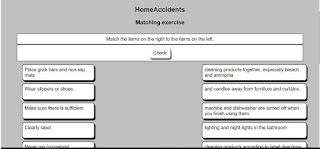Using Websites
Using
Websites
I am
going to use some of the websites evaluated in the previous post to design two
lesson plans about ‘Preventing home accidents’ and ‘My First Aid kit’. I am
going to follow Dudeney & Hockly's (2007) model on lesson plans considering the
three stages: warmer, web and what
next.
This
topic-based unit is about ‘Preventing home accidents’. The first lesson deals
with different kinds of accidents and injuries that may occur at home and how
to prevent them. And the second lesson
is based on the First Aid Kit and the items that are necessary in case of an
emergency.
These
lessons are aimed at my 17-year-old students in a school where they have
English lessons three times a week ( one lesson is 120 minutes long and the second one is 60 minutes long). They are at an upper-intermediate
level so they can easily work on authentic websites on their own. In groups of three, students will be working
on a computer.
- Course: 5th year
- Level: Upper intermediate
- Number of students: 24
- Length of time: 1st lesson 120 minutes long; second lesson 60 minutes long.
- Unit: Preventing home accidents
- Lesson 1: Preventing Home Accidents
I will write the following on
the board: ' _________ is where the greatest accident risk is.'
Students will have to think about the
place where most accidents happen. I will write their different suggestions on
the board.
Web:
Students will read the title of the following
article Home accidents risks and check their guesses in the previous stage.
I will go on to mention that ‘home’
is the place where most accidents are likely to happen. Now, students read the
text and why our home may be a place for accidents if we do not pay attention
to small daily details.
I will ask students if, according to
the article they have read, their home is as safe as they think it is and they should also mention what everyday objects or actions may be the cause of a possible accident.
I will write on the board a list of possible home accidents. ( Falls, Food and medicine poisonings, fires and burns, electrical safety, water-related injuries and flooding, heating and cooking, suffocation and cuts) Each group will be assigned a common hazard; the aim is to navigate the following links and find out at least 3 tips to bear in mind so as to prevent home accidents.
3. Home Safety
What next:
As a round up activity, students work on the following task sheet so as to see oif they remember what other groups have worked on. To do the activity, students have to click Home Accidents. Then go to ' descargas' and download the file. Next they have to open it with their browser and they will be able to see the activity.
- Lesson # 2 Preparing my First Aid Kit
Warmer:
I will ask students what a First Aid Kit is and if they have one at home and if they do, what that kit contains.
Web:
Students will be reading the following websites and draw a list of the 10 most necessary and useful items needed to prepare a First Aid kit. They also have to find what each item is used for.
1- How to create a First Aid Kit. Here students will be watching a video explaining what contents should the first aid kit should have.
I will ask students what a First Aid Kit is and if they have one at home and if they do, what that kit contains.
Web:
Students will be reading the following websites and draw a list of the 10 most necessary and useful items needed to prepare a First Aid kit. They also have to find what each item is used for.
1- How to create a First Aid Kit. Here students will be watching a video explaining what contents should the first aid kit should have.
What Next:
Students will solve a crossword based on the previous websites. To do the activity, they will have to click First Aid Kit, adownload the file and then open it with their browser. The crossword will display on the screen.
References:
- Campbell, D. (2014, December 12). Home is where the greatest accident risk is, warns top A&E doctor. Retrieved from https://www.theguardian.com/society/2014/dec/12/home-accident-risk-nhs-doctor
- · Alt, K. (2017, May 9). Home accident statistics: Is your home as safeb as you think? Retrieved from - https://www.asecurelife.com/home-accident-statistics/
- Oldani, P. (2019, April 13). How to create a first aid kit for the everyday and the extreme. Retrieved from https://insidefirstaid.com/first-aid-kit/how-to-create-your-personal-first-aid-kit
· Mackenzie,
L. (n.d.). Preventing accidents in the home. Retrieved from https://www.rospa.com/home-safety/advice/general/preventing-accidents-in-the-home
· Wound Care: Your Essential First Aid Care Guide. (n.d.). Retrieved from https://www.webmd.com/a-to-z-guides/wound-care-10/preventing-common-home-injuries
· First
aid kit contents and supplies checklist. (n.d.). Retrieved from https://www.sja.org.uk/sja/first-aid-advice/first-aid-techniques/how-to-use-your-first-aid-kit.aspx
· Firs Aid Kit. (n.d.). Retrieved from https://www.aboutkidshealth.ca/Article?contentid=1038&language=English
· Firs Aid Kit. (n.d.). Retrieved from https://www.aboutkidshealth.ca/Article?contentid=1038&language=English












I don't have access to the task sheets prepared with an authoring tool. I think that you should upload it to the cloud and allow the public to see it. It would be good if you could explain a bit more what students are supposed to do in each lesson, if there is a conclusion (allow them to reflect on what they have learned) and to make the objectives clear to students.
ResponderBorrar